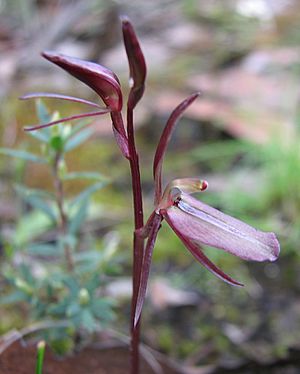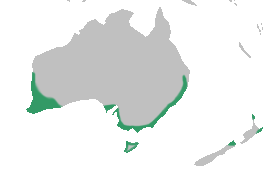Gnat orchids facts for kids
Quick facts for kids Gnat orchids |
|
|---|---|
 |
|
| The common gnat orchid, Cyrtostylis reniformis | |
| Scientific classification |
|
| Kingdom: | Plantae |
| Clade: | Tracheophytes |
| Clade: | Angiosperms |
| Clade: | Monocots |
| Order: | Asparagales |
| Family: | Orchidaceae |
| Subfamily: | Orchidoideae |
| Tribe: | Diurideae |
| Subtribe: | Acianthinae |
| Genus: | Cyrtostylis R.Br. |
 |
|
| Distribution | |
Cyrtostylis, commonly known as gnat orchids, is a group of five or six types of flowering plants. They are part of the large orchid family called Orchidaceae. These unique plants grow naturally in Australia and New Zealand.
Gnat orchids often grow in big groups. These groups are made up of plants that are genetically identical, like clones. Each plant has one heart-shaped leaf that lies flat on the ground. A thin stem grows up from the plant, holding pale, insect-like flowers. The side parts of the flower, called sepals and petals, are similar in size and color. The main lip of the flower, called the labellum, looks like a small shelf. It has two noticeable bumps, or glands, at its base.
What Gnat Orchids Look Like
Orchids in the Cyrtostylis group grow in the soil. They are perennial plants, meaning they live for more than two years. They are also deciduous, which means their leaves die back during certain seasons. These plants usually have a few small roots and one or two round underground storage parts called tubers.
They often form large groups of cloned plants. This means all the plants in a group are exact copies of each other. Each gnat orchid has a single green, heart-shaped leaf. This leaf usually lies flat on the ground at the base of the flowering stem.
The thin stem holds one to a few flowers. The main part of the flower, called the column, is at the top. The flowers are usually pale in color. The top sepal stands upright, while the side sepals and petals spread out. The petals and sepals are narrow and pointed, and they are all about the same length.
The labellum, or lip, of the flower has no stalk. It is oblong and about as long as the sepals and petals. It has two small, bead-like glands and two ridges along its length. The column is curved and has small wings. It is about half as long as the labellum.
Gnat orchids look similar to plants in the Acianthus group. However, Cyrtostylis orchids do not have the long, tail-like parts on the ends of their sepals and petals that Acianthus plants have. Also, the side sepals and petals are different in Acianthus plants.
Naming Gnat Orchids
The Cyrtostylis group was first officially described in 1810. This was done by a botanist named Robert Brown. He wrote about it in his book Prodromus Florae Novae Hollandiae. At the same time, he described the Cyrtostylis reniformis, which became the main example, or type species, for the group.
The name Cyrtostylis comes from two Greek words. Cyrtos means 'curved', and stylos refers to the 'style' or column. This name describes the curved column found in all gnat orchids.
There are about five or six different types, or species, of Cyrtostylis orchids. Some experts list five, while Australian experts list six. The main difference is how they classify Cyrtostylis huegelii.
Here are some of the known species of gnat orchids:
- Cyrtostylis oblonga (found in New Zealand)
- Cyrtostylis reniformis - also known as the common gnat orchid (found in all six states of Australia)
- Cyrtostylis robusta - also known as the large gnat orchid (found in South Australia, Western Australia, Tasmania, and Victoria)
- Cyrtostylis rotundifolia (found in New Zealand)
- Cyrtostylis tenuissima - also known as the dwarf gnat orchid (found in Western Australia)

